Wetherby, West Yorkshire
Up to 1834
A small poorhouse called Stone Dene existed on North Street in Wetherby. Another operated at the south of Kirk Deighton, just to the north of Wetherby.
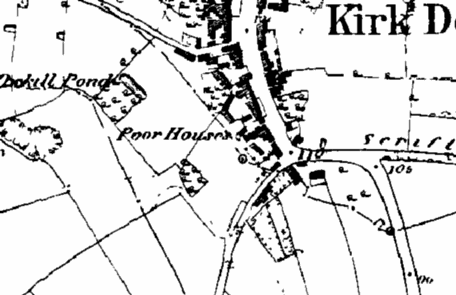
Kirk Deighton site, 1850.
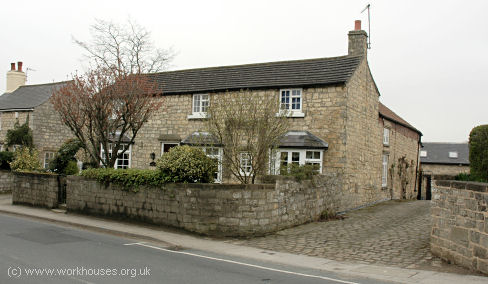
Kirk Deighton former workhouse site, 2006.
© Peter Higginbotham.
After 1834
The formation of new Poor Law Unions in West Yorkshire was severely hindered by the existence of four Gilbert Unions (Barwick, Carlton, Great Ouseburn and Great Preston) whose constitution had made them exempt from the provisions of the 1834 Poor Law Amendment Act. The scattered distribution of these Gilbert Unions cut across the neat pattern of Poor Law Unions proposed by the Poor Law Commissioners as shown on the map below.
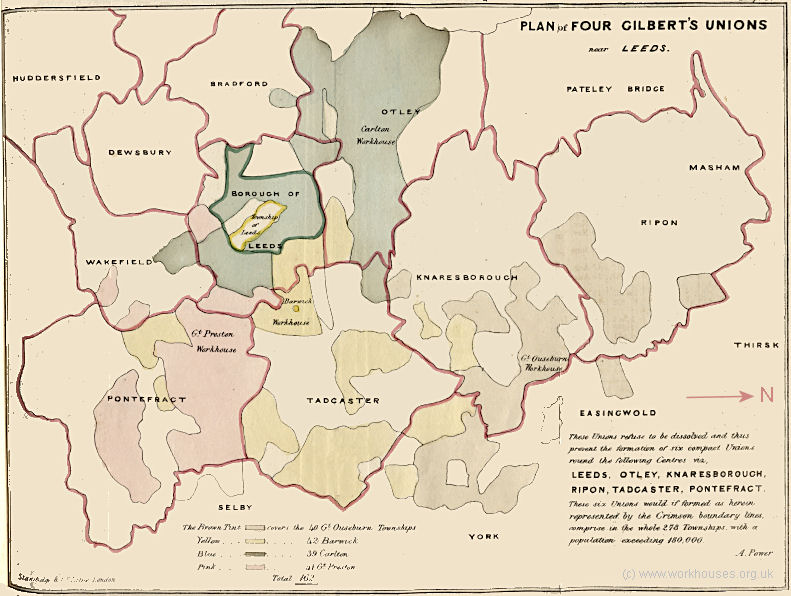
Yorkshire Gilbert Unions map, 1838.
© Peter Higginbotham.
It was not until 1850s that the Commissioners' scheme began to take place with the formation of the new Unions of Ripon (1852), Knaresborough (1854), Wharfedale (1861), Wetherby (1861), and Tadcaster (1862).
The new Wetherby Union formally came into existence on 15th February 1861. Its operation was overseen by an elected Board of Guardians, 21 in number, representing its 19 constituent parishes and townships as listed below (figures in brackets indicate numbers of Guardians if more than one):
West Riding of Yorkshire: :
Angram, Bardsey with Rigton, Bickerton, Cowthorp, North Deighton, Healaugh, Kearby with Netherby, East Keswick, Kirkby Overblow, Linton, Little Ribston, Rigton, Scarcroft, Sicklinghall, Spofforth with Stockeld (2), Weardley, Wetherby (2), Wighill, Wothersome.
Later Additions: (from 1869): Bilton, Bramham cum Oglethorpe, Bramhope, Clifford, Collingham, Dunkeswick, Harewood, Hutton Wandesley, Kirk Deighton, Long Marston, Micklethwaite, Pool, Shadwell, Swinden, Thorner, Thorp Arch, Tockwith, Walton, Weeton, Wigton, Wilstrop, and Wyke. Boston Spa joined the union in 1896.
The population falling within the original union at the 1851 census had been 6,497 with parishes and townships ranging in size from Wothersome (population 21) to Wetherby itself (1,494). The average annual poor-rate expenditure for the period 1858-60 had been £1,742 or 5s.4d. per head of the population.
A Wetherby Union workhouse was built in 1862-3 on Linton Road in Wetherby and was designed by JB and W Atkinson. The site location and layout are shown on the 1893 map below.
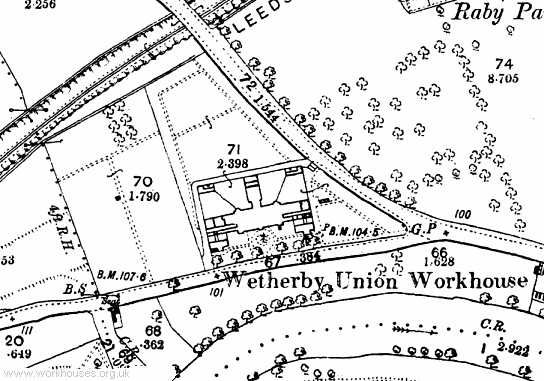
Wetherby workhouse site, 1893.
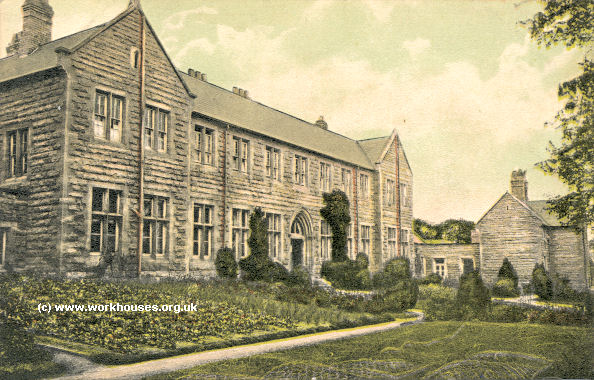
Wetherby main block from the south-west, c.1915.
© Peter Higginbotham.
The original building had a T-shaped main block facing south into Linton Road. The Master's quarters were at the centre, with male accommodation to the north and female to the south, with a kitchen at the rear. Small casuals' blocks were located to side of the front of the main block, with the one for males at the north being extended in 1896. The male casual ward included sheds for wood sawing and wood chopping. In January 1907, a 20-bed single storey infirmary was opened at the west of the workhouse at a cost of £2,000.
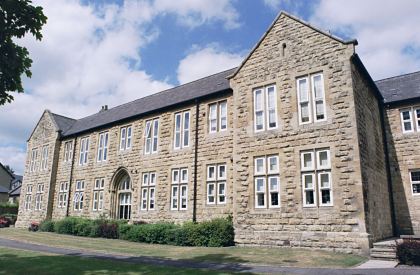
Wetherby main block from the south-east, 2001.
© Peter Higginbotham.
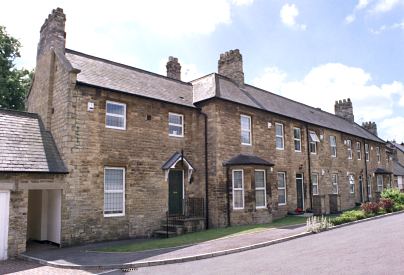
Wetherby main block from the north, 2001.
© Peter Higginbotham.
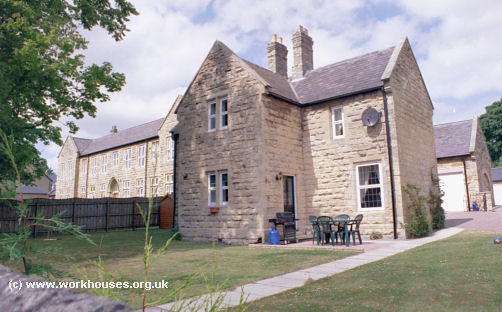
Wetherby casuals' block from the south-east, 2001.
© Peter Higginbotham.
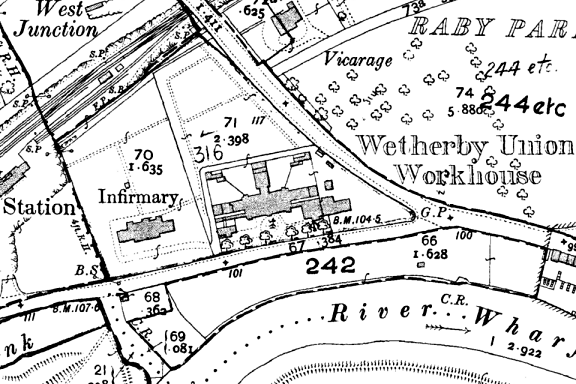
Wetherby workhouse site, 1907.
In 1930, the former workhouse came under the control of the West Riding County Council. An architect's report on the buildings noted that, unlike some other establishments in the county, Wetherby workhouse was lit throughout by electricity. Drinking water came from a mains supply but was too hard for use in washing and bathing so water for these purposes was pumped from the river into storage tanks. Central heating was installed only in the infirmary and the male casual ward. The main block was heated by open fires and had only one bathroom which was shared by the staff and female inmates — male inmates had to use the bath in the casual ward. The workhouse still had its own pig-sties at the north-west of the main yard, with five pigs being reared in 1930.
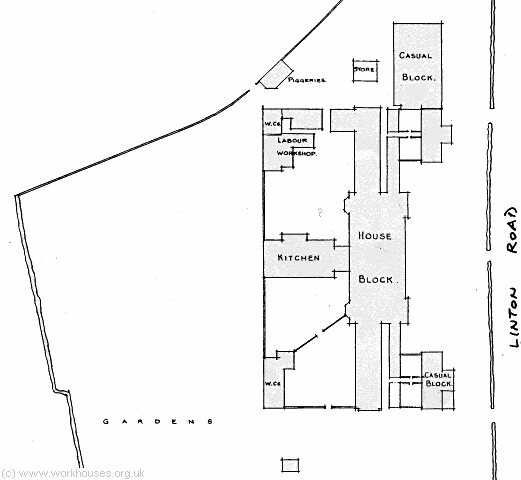
Wetherby workhouse plan, 1930.
© Peter Higginbotham.
The county architect's report in 1930 found the buildings to be old-fashioned and unsatisfactory and recommended that the institution be closed. However, a new role was found for it and it was used to provide care for elderly women and for the mentally handicapped. After the creation of the National Health Service, it became known as Wharfe Grange Hospital, finally closing in January 1993. The site has now been redeveloped for residential use.
Staff
Inmates
Records
Note: many repositories impose a closure period of up to 100 years for records identifying individuals. Before travelling a long distance, always check that the records you want to consult will be available.
- West Yorkshire Archive Service (Leeds Office), Nepshaw Lane South, Morley, Leeds LS27 7JQ. Virtually no local records survive.
Bibliography
Links
- Ripon Workhouse Museum and Garden, Sharow View, Allhallowgate, Ripon HG4 1LE.
Unless otherwise indicated, this page () is copyright Peter Higginbotham. Contents may not be reproduced without permission.


